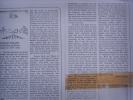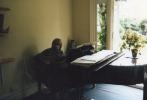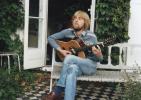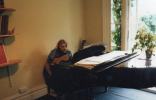"The magnificent eight revisited" - Anthony Phillips talks about the eight albums in the Private Parts & Pieces series re-issued by Esoteric Records. Interviews by Alan Hewitt and Jonathan Dann. Memorabilia: TWR/Pavilion archive, and Jeremy Charlett. Photographs by Carol Willis, Ted Sayers and Jonathan Dann.
Continuing the look back at Ant’s albums and our conversations with him about them, I thought it might prove interesting to read what he had to say about them to our sister publication: The Pavilion and so, lovingly remastered, are Ant’s thoughts on the first eight of this long running series. Beginning with….
"Private Parts & Pieces" - readings from the first chapter of the affectionate scrapbook. (originally published in #5 of The Pavilion).
INT: What was the rationale behind releasing this particular album?
AP: Well there was no rationale really, it was actually an accident. It was not possible to get any acoustic material released at that time. Sides was being made and there was a lot of pressure to be more commercial. I made the compilation up largely because I was told by Tony Smith (Ant’s manager at the time - AH) that Brian Eno had a label that was just starting off which might put out instrumental music. So the compilation was made up just of things that I had recorded throughout the ‘70’s at home and Eno’s company weren’t interested at all apparently, as they were aiming for the more ambient, synth based things.
I had rather given up on the idea after that. But when Sides came to be released, the idea of the album coming out with it turned up, although I can’t remember whose idea it was. At the time a lot of people said that it was very refreshing to hear more acoustic pieces like that. There is no doubt that without the support of Tony Smith for the idea it would not have happened.
INT: Where was the album released first? Did it come out in its own right in the States before appearing in the UK?
AP: I’m afraid I can’t remember, we are doing this interview about fifteen years too late! (Laughs). I think the album appeared almost simultaneously or at least within a few weeks of each other. There was certainly no great gap between the two releases. I remember doing a promo tour for Sides in the summer of ‘79 so I feel that Private Parts & Pieces came out later in the States.
INT: Tell us a little bit about each track on the album… |
|
AP: The album did account for the best of the music that I recorded at home. Recording in those days was very different as you had to go to big outside studios if you wanted to record anything of any size. Home recording studios didn’t really stretch to doing anything with much scope or a great number of tracks to it. So I just used to record acoustic guitar pieces and piano pieces as well as the occasional simple song throughout the ‘70’s. There were a couple that came from before 1974 and then some more that came from the summer of 1976 when I was trying to forget what was NOT happening to The Geese & The Ghost at that time.
Beauty & The Beast was an early piano piece where I experimented with things like different speeds. Field Of Eternity was an early long instrumental pieces which I took this guitar piece out of and developed it into a solo. Tibetan Yak Music was from around the time we were doing some of the Tarka demos in early 1976; that was recorded with Harry Willimson. As I played he was changing all the graphic equalisation sot he guitar goes through timbre shifts. That was virtually improvised.
Harmonium In The Dust came from ‘74, just before The Geese & The Ghost. Once again it was just a harmonium based piece. I didn’t have a synthesiser then so that was the only sustained sound available! The guitar piece called Reaper actually dates back to 1970, just after leaving the group. Seven Long Years was a lullaby that dates from ‘74. I was lucky in a way to be able to draw on the best bits from seven or eight years’ worth of writing and recording. |
|
Autumnal was a piano piece from 1972 and I was given a lot of encouragement by Mike Rutherford at that stage. Autumnal was subsequently orchestrated for inclusion on The Geese & The Ghost and we did record a demo version of it that exists somewhere. It was played to Tony Stratton-Smith and he didn’t go for it at all. He didn’t like Collections either!
INT: Was all of the material written by yourself for the album apart from Field Of Eternity?
AP: Yes, although I credited Mike for that track as it seemed only fair in some respects. There is a snatch from the theme of Pacidy in that which was basically Mike’s theme. The rest of the material was “home grown” although Harry played an important part in the sonic reproduction on Tibetan Yak Music. I recorded a fair amount of piano pieces during 1972 and Back To The Pavilion from the next album was done at exactly the same time.
INT: Where did the idea for the title come from?
AP: I think it was my title actually. I knew Peter Cross pretty well by that stage and we had developed a nice line in puns so that’s where that came from. The visual idea of the character with his kit bag was definitely Peter’s idea. I seem to remember Tony Smith being fairly receptive to it as well.
INT: Did Peter have the chance to hear the music before he did the cover?
AP: Yes he did. The thing that sticks in my mind the most about the album is the fact that at the time I had no idea about making a master up for an album. I had mixed a lot of the stuff down myself and as a result there were a certain amount of technical errors. When I took the tapes to Trident Studios to master it, Ray Staff had to do a lot of work on it as there were so many problems with it. There are all sorts of weird and wonderful things going on if you listen to the album closely. In the pre-CD era things had to sound right or they couldn’t physically be cut on to record. That was the famous time when Ray said “it would be a piece of cake to cut” ! The earliest pieces would have been recorded on two track on a Revox and the later pieces were recorded on a four track TEAC . By that time I also had DBX noise reduction which helped. Beauty & The Beast was actually recorded in “fake” stereo as I was flipping from one track to another within the machine. On that piece both tracks are slightly out of sync with each other but it is fast enough not to matter.
INT: One thing that ties in with this period is the music book - Six Pieces For Guitar. One of those pieces is Field Of Eternity, but have any of those other tracks been recorded?
AP: Nocturne I also in there and one of the studies is actually Spring Meeting. That is the only manuscript that I have had published as it is very hard to get guitar music published. We did try pretty hard to get the scores of Antiques published but that didn’t happen as we weren’t well-known rock stars or avant garde composers. If you publish difficult works then it means that only a few people can play them and they don’t make much money from it so you have to aim for simple pieces that everyone can play. I am not so commercially minded so I didn’t think about toeing the line and doing simple stuff at first. The contact with Weinberger was through Morris Pert as he had works published by them. One day it would be great to have more of the scores available. |
|
INT: Coming more up to date with the CD issue of the album, there were, of course, the two extra tracks added to the album. Tell us a little about each of them…
AP: With Silver Song, I did a number of versions of the track over the years. There was an attempted single version done under the auspices of Arista which was done during an all-night session with Rupert Hine, John Perry and Trevor Morais. The strange thing with that track is that often the punters like it but the musicians don’t. The only result of that session was wasting the record company’s money! Every time a project came up it was a case of trying to get Silver Song in there somewhere! Bits of it even ended up in Alice! (laughs). The version included on the CD comes from a period where a number of us were trying to write some songs for an Eric Clapton album which Phil Collins was producing. So, I had a go at making it slightly countrified so that’s why that version is as it is. That must have been version 47B! (laughs).

Stranger was a new recording as the original had too many mistakes in it. It may well be that the best version of that was the one from 1970 that was lost along with all those original tapes (of course, we now know differently don’t we? - AH). Stranger dates back to 1969. Genesis used to do that and the others called it “Strangler” as I couldn’t make the high notes in the middle section! One of the early Genesis tapes which we recorded with Alec Reid (the producer of the Night Ride session) had a version of that on it played by the band.



